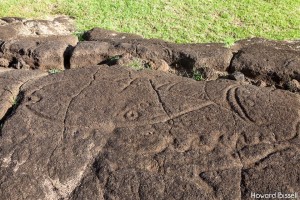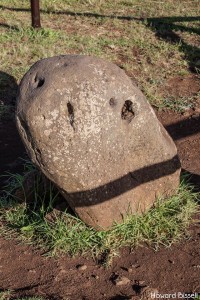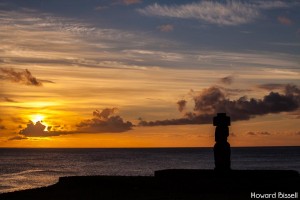Our plan is to take sunrise photos at Ahu Tongariki, the 15 statue platform. We wake up to rain but Rex suggests to go anyway and he was right! We arrive at the platform just in time for incredible photos.
Rex has brought breakfast with us so after refreshment we head out to see the nearby sites. Next stop is Papa Vaca, a spectacular series of stone panels with a myriad of petroglyphs . At this site is a sweet female dog and her puppies. The mother is affectionate and sweet; the puppies are wary. It is a constant heart-breaking scene here in Chile and Eater Island. There are millions of street dogs that are thin and sick and there is nothing for us to do.
. At this site is a sweet female dog and her puppies. The mother is affectionate and sweet; the puppies are wary. It is a constant heart-breaking scene here in Chile and Eater Island. There are millions of street dogs that are thin and sick and there is nothing for us to do.
We make a roadside stop at a Pu O Hiro, a medium-sized stone with a series of holes in it as well as fertility petroglyphs.  Blowing into the holes makes a trumpet-like sound and is supposed to call the fish. We did not attempt to call the fish…
Blowing into the holes makes a trumpet-like sound and is supposed to call the fish. We did not attempt to call the fish…
Next stop is Te Pito Kura. The Moais on this platform are thought to have been thrown over on the ground more than 200 years ago. The statue is giant; it is the largest Moais to have ever been transported from the quarry to a platform. This Moais was the last to be seen upright by French explorer, Abel Du Petit-Thousrs, in 1883.
To the left of the platform is a large, perfectly round stone. Legend says that the island’s first king brought this stone with him on his journey here. It is said to have heavy doses of “mana,” a spiritual power bestowed by the gods. But it appears the stone is entirely of island origin. It has a high iron content resulting in erratic behavior of compasses in its proximity. Some call it “The Navel of the World.”
We find a “secret” beach that Rex visited 20 years ago. Apparently it is a pink sand beach parts of the year depending on the current. This time, unfortunately, it is just a rocky inlet. But the incredible splashing waves on the rocks is an incredible sight.
Puna Pau is the quarry where the topknots for the statues were made. The topknots were a recent addition to the Moais–probably beginning in the 15th or 16th century. The stone used (and quarried here) is a soft volcanic rock with high iron content (thus red in color). The “hats” or “topknots” are thought to be representations of the hairstyle of the times: long hair worn in a bun near the top of the head. Hey, my nephew looks like that!
We have lunch at Dominican Cafe. Of course we start with Pisco Sours–frozen, slushy ones. We have GREAT tuna in caper sauce with sweet potato chips. We are happy to sit inside out of the WIND.
We are lazy the rest of the afternoon. At 7:30 we go out for sunset photos at the nearby beach. Rex buys wine and hunts up wine glasses. Just as we are having a nice time at the beach, sipping wine and the guys are enjoying the sunset photography, some lady tells me to get rid of the wine. I am polite and quickly put away the wine. I guess fortunately for her I have not had enough wine to be argumentative. I’d hate to see Easter Island from the inside of its jail.
some lady tells me to get rid of the wine. I am polite and quickly put away the wine. I guess fortunately for her I have not had enough wine to be argumentative. I’d hate to see Easter Island from the inside of its jail.
Howard and I spend a quiet night at the hotel sipping a new drink: Cherimoya cocktail. And it’s pretty good. Oh yeah, my knee is a real problem…
